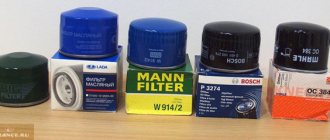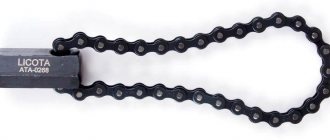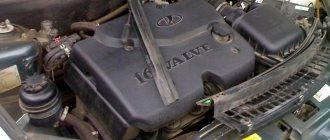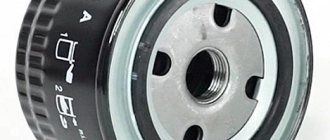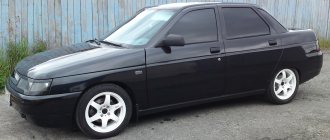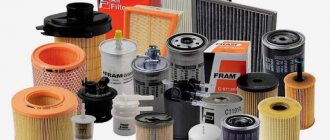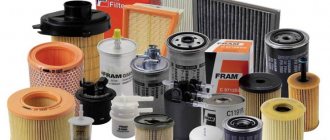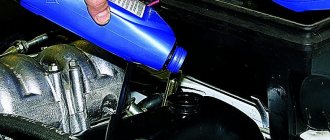FILTERS “SPIN ON”
The whole world of oil filters in a unique super table, and only in ZR!
We started our review of oil filters in the previous issue with cartridges - open-frame elements. Much more common are case ones, or, as they are called in English, “spin on”, that is, literally “screwed on”. Over 90% of passenger car engines in the world are equipped with this type. Unlike replaceable cartridges, everything in them is disposable: the filter curtain, frame, seals, valves, and even the body itself. Hence - a noticeable reduction in the labor intensity of maintenance: unscrew the old filter, screw on the new one - and order!
Most of the filters produced in the world are similar in design to our “Zhiguli” (of course, we are not talking about quality!), that is, they contain two valves - a bypass and an anti-drainage valve (Fig. 1). The first one can sometimes stand at the filter inlet (it does this, see ZR, 1996, No. 9), accumulating large wear particles in the housing and not allowing them back into the engine. On some engines, designers do without an anti-drainage valve - there is no need for it if the filter is positioned with the cap down and oil cannot leak into the crankcase when parked. Or, instead of a bypass valve at the inlet, an anti-vacuum valve is installed at the outlet - it opens only by pressure from the inside, preventing the rapid drainage of oil from the filter. The filters of all Audi and Volkswagen gasoline engines are made according to this scheme. Sometimes, for reliability, both anti-drainage and anti-vacuum valves are used - this is how the filters of Land Rover all-terrain vehicles, as well as some Mazda and FIAT engines, are designed (Fig. 2). And in the filters of many Nissan, Opel and GM engines there are no valves at all, even the most important one, the bypass valve. The designers placed them permanently in special spacers - a spring-loaded ball or plunger is more reliable than disposable cuffs.
Now let's move on to practice: which filter is suitable for your specific machine? Firstly, its thread must match that on the engine fitting. Secondly, the outer diameter of the gasket should be close to the diameter of the annular protrusion around the fitting, the so-called socket. Thirdly, the base of the filter must be as concave as the standard one, otherwise there will not be enough space for the hexagon of the fitting and the gasket will not press tightly against the socket. Fourthly, the filter should be close in size to the standard one. One that is too large may not fit in the space allotted to it under the hood. It’s even worse if it fits, but becomes crumpled when the suspension is activated or the engine moves on elastic supports. But it is not advisable to install one that is much smaller than the standard one, because the designers specifically calculated the required minimum area of the curtain. For example, diesel filters are always larger than those of gasoline engines of equal power. Heavily loaded parts require additional oil cooling (diesel oil pumps have higher performance), and the diesel filter curtain is capable of allowing additional oil to pass through. The same thing applies to the forced engines of GTi modifications. The most striking example is the Porsche air vents, which use a huge filter from Caterpillar and IVECO “truck” diesel engines.
And finally, fifthly, the set of filter valves must be no less than the standard one. For example, in the absence of a proper bypass valve, the curtain will break at the first cold start, and without an anti-drainage valve, the motor will run dry for half a minute each time - in both cases, accelerated wear is inevitable. But extra, unnecessary valves will not do any harm - the engine simply will not notice their presence.
Let's talk about connecting dimensions. About 75% of all housing filters for passenger cars, mainly European and American, are designed for a “European” socket with a nominal diameter of 71.5 mm. Motor filters of Japanese origin (no matter where they were made: in Japan, Europe, America or Korea) are consistent with a “Japanese” socket with a diameter of 63 mm, and there are about 20% of them. The remaining few models are designed for diesel engines with “cargo” sockets. For example, the Ford Transit 2.5D has a diameter of 92 mm. It’s more difficult with the threads for the fitting - there are twelve of them for filters of passenger cars only: five inch and seven metric. The most common thread is inch ¾”-16UNF, that is, with a diameter of 19.05 mm and a pitch of 16 threads per inch (1.59 mm) - such fittings are found on engines of most companies in Europe, America and Japan. Then comes M20x1.5MV - it is used mainly in France and Japan. M18x1.5MV is traditionally French, but since 1984 it has become the hallmark of filters for Opel, and then GM, and, of course, Korean Daewoos.
Other filter threads are specific to a narrow group of vehicles of certain brands. For example, M22x1.5MV is used only on Ford Transit trucks and old Hondas. And threads M24×1.5MV and M26×1.5MV are only on diesel engines: the first is for Toyotas, the second is for Mitsubishi and Mazda. Even M30x1.5MV is provided for filters of large diesel engines of Land Cruiser all-terrain vehicles. The rarest of the “filter” metric threads, M16×1.5MV, can be seen only on Peugeot and Citroen minicars, starting from the humpbacked “De Shvo”.
Of the inch threads, the second most common is 1″-12UNF (diameter 25.4, pitch 2.12 mm). In addition to diesel engines, it is used on filters of powerful gasoline engines of Jaguars and Porsches. The other three are: 13/16″-16 UNF (20.64×1.59 mm), 1 1/8″-16UNF (28.58×1.59 mm) and 5/8″-18UNF (15.88× 1.41 mm) - only on filters of American and British cars.
Which oil filter for LADA cars is better to choose
The oil filter is designed to remove contaminants from the engine oil.
Oil filters differ not only in size and mounting, but also in the opening pressure of the bypass valve. Let's figure out which oil filter should be installed on modern Lada cars. The modern line of 8 and 16 valve VAZ engines (detailed table) is used on cars such as Lada Granta, Priora, Kalina, Largus, Niva, Vesta or XRAY. The manufacturer's recommendations regarding the use of oil filters are the same for all modern VAZ engines, and accordingly for these cars. Where the oil filter is located is shown in the diagram (position No. 11):
The manufacturer recommends changing the oil filter along with the engine oil. The catalog numbers of oil filters should be as follows:
- 21050-1012005-00;
- 21080-1012005-00;
- 21080-1012005-08;
- 21080-1012005-09.
- 152085758R (for Renault-Nissan engine on Lada XRAY)
Currently, the oil filter can be produced in various types, “Nevsky”, “Mahle”, etc. So, which oil filters are good? Reviews of popular car magazines have repeatedly checked the service life of filters of different brands, while monitoring the quality of filtration of the reference mixture. Based on the presented ratings, it is impossible to accurately determine the leader, because... The TOP 10 varies depending on the source. For example, the popular Bosch P3274 oil filter took first place according to one online magazine, but in another source it occupies only 6th position.
According to a survey among VAZ 2110 owners, the TOP 5 oil filters are as follows:
To the question : What brand of oil filter is installed on Vesta from the factory? Which brand of oil filter is recommended for installation?
AvtoVAZ responded like this:
Beware of fakes. Try to buy an oil filter in trusted stores or from an authorized dealer. Sometimes a fake can be identified by certain criteria, for example, for MANN filters: the box should indicate the website, the PCT sign, and instead of “Germany” it should say “Germany”. The anti-drainage valve should be white, the instructions should be graphic and not text, etc. What oil filters can you recommend? Let us remind you that filter replacement is presented in this manual.
What is he?
Now oil filters are produced as a single element that cannot be disassembled. The body is traditionally made of metal, in which the filter material and 2 valves are located. One of them is needed to prevent the backflow of the lubricant; it is called anti-drainage. The second one is specialized for passing the motor lubricant mixture through the filter if it becomes clogged or the anti-drainage filter gets stuck. Likewise, the bypass valve will operate if the oil is of high viscosity and has difficulty passing through the filter material. This valve is needed so that the engine lubricant mixture can freely reach all engine systems, even if the oil filter completely fails. It is also necessary to retain a certain amount of motor lubricant directly in the filter housing itself when the power unit is turned off. This is necessary to ensure instant lubrication of all engine systems during engine startup.
AvtoVAZ responded like this:
Beware of fakes. Try to buy an oil filter in trusted stores or from an authorized dealer. Sometimes a fake can be identified by certain criteria, for example, for MANN filters: the box should indicate the website, the PCT sign, and instead of “Germany” it should say “Germany”. The anti-drainage valve should be white, the instructions should be graphic and not text, etc. What oil filters can you recommend?
If you find an error, please select a piece of text and press Ctrl+Enter.
Selecting an oil filter for VAZ 2108
Despite the fact that the G8 was discontinued from mass production a long time ago, it is still a popular car in our country.
The maintenance process is not at all complicated and does not take much time.
So, for example, replacing an oil filter (hereinafter referred to as MF) is carried out “in no time”, if you have a special puller.
Replacement frequency
The frequency of replacing the air filter directly depends on the operating conditions of the vehicle. Typically, the interval before installing a new filter is 20-30 thousand km. In certain circumstances, unscheduled air filter replacement may be necessary. Such situations include:
- significant loss of dynamics;
- increased fuel consumption;
- there is through mechanical damage to the filter element;
- the car needed to cover a long stretch of dirt and dusty roads;
- there are significant deformations of the filter element;
- it is unknown when the previous consumable replacement was performed;
- The filter element is significantly filled with oil.
How to distinguish a fake from an original filter
You can purchase consumables, including MF, in various places, namely:
- at the car market;
- in a specialized store;
- in online catalogues;
- through intermediaries.
Given the breadth of choice, for an inexperienced owner the risk of purchasing non-original products increases due to insufficient knowledge of unmasking factors.
When selecting consumables, be sure to check the availability of:
- and integrity of branded cardboard packaging;
- holographic protection from the front of the package;
- factory stamp with batch number, date of manufacture, country of origin;
- rubber seal on the inner diameter of the MF.
When purchasing, check for a quality certificate or other documentary materials indicating the origin of the product. If in doubt, refuse.
Reviews on the choice of original and non-original filters
Kirill Vyacheslavovich, 42 years old, Petropavlovsk: I bought a VAZ 2108 two years ago, the car is good, no comments. I take care and follow the maintenance schedule. Before visiting a service station, I always purchase consumables. In particular, I always take fuel and oil filters with original serial numbers (Mann, Livny). My comrades buy high-quality analogues, they are cheaper. I believe that there is no need to cheapen consumables. The service life of the power unit directly depends on the quality of lubricant cleaning.
Nikolaevich, 39 years old: I bought a VAZ 2108 car secondhand, got it from the previous owner in good condition. During two years of active operation there were no serious breakdowns, only scheduled maintenance. I don’t buy original filters, I limit myself to high-quality analogues, they are a third cheaper. I always order from the online store, it has been tested over the years, my recommendations to motorists. I believe that there are no fundamental differences between factory products and analogues, with the exception of cost.
Do-it-yourself installation of a zero-resistance filter
The installation process of the “nulevik” is also quite simple and can be done independently. To do this you will need a set of keys and a Phillips screwdriver.
Under the hood we find the VAZ-2110 air filter housing. Disconnect the ground terminal on the battery. Disconnect the MAF connector. Using a screwdriver, loosen the clamp screw and remove the corrugation going to the engine.
Using a 10mm wrench (preferably a socket wrench), unscrew the nuts securing the mass air flow sensor to the filter housing. We dismantle the filter housing and remove it.
Using a Phillips screwdriver, remove the screw securing the ground wire to the cylinder head. Under this screw we install the bracket for fastening the air flow sensor that comes with the filter. We mount the sensor to the bracket using a 10mm bolt. The connection must be sufficiently rigid, otherwise the mass air flow sensor will fail due to vibration.
We attach the corrugation to the back of the sensor and fix it by clamping the clamp. We put the filter itself on the front of the mass flow sensor and press its pipe using a clamp. We connect the sensor connector, connect the terminal.
For normal and long-term operation of the power unit, timely replacement of the air filter is important. It cleans the air of dust and abrasive particles, which causes it to gradually clog.
During operation, the throughput decreases and the engine begins to “choke.” Because of this, the revs fluctuate, the car significantly loses dynamics, and gasoline consumption increases. This is why timely replacement of the filter element is so important for a vehicle.
ATTENTION! A completely simple way to reduce fuel consumption has been found! Don't believe me? An auto mechanic with 15 years of experience also didn’t believe it until he tried it. And now he saves 35,000 rubles a year on gasoline! Read more"
Oil filter VAZ 2114
VAZ 2114 was produced from 2003 to 2013. From the factory, the car was equipped with a gasoline engine with volumes of 1.5 and 1.6 liters. The oil filter does not differ depending on engine size. Every 10 - 15 thousand kilometers on a VAZ 2114 car must undergo maintenance to change the oil, during which it is also necessary to replace the oil filter.
Oil filter LADA 21080101200508
A filter is installed on the car from the manufacturer under the catalog number LADA 21080101200508 . The main supplier of oil filters for VAZ cars is. Supplied in original packaging with LADA symbols. The average price of an oil filter is 190 rubles. Most customer reviews are negative. The weak point of the spare part is the low quality of the filter element. There is also a problem with the return valve. After starting the engine, the oil pressure sensor does not go out for 4 - 6 seconds. The valve does not keep oil inside the filter when the engine is not running, and during startup the oil pump re-charges oil.
Also, one of the suppliers of oil filters for the VAZ 2114 is. Some models were equipped with an original oil filter from this company - Salyut 21081012005010 . Price – 160 rub. One of the negative aspects is the low-quality filter paper, in the curtains of which holes often appear during operation.
Data for transport companies:
Approximate weight of goods with packaging: 1 kg Approximate volume of goods with packaging: 0.01 m3
EXAMINATION: VAZ oil filters. Cirrhosis of the liver
After all, the engine has its own brain - the controller, its own nervous system - the electrics, the heart - the cylinders, the blood - the motor oil. Only the reproductive organs are missing, which is a pity... But the engine also has its own liver, that is, an organ that serves to cleanse the body: a kind of dump, a garbage heap! This is an oil filter. And, fortunately, it can and should be changed at every oil change - the engine does not need liver cirrhosis!
Oil filter analogues
When choosing an oil filter for a VAZ 2114, you can pay attention to substitutes. Parts from domestic manufacturers have several common weaknesses - a low-quality filter element and a weak check valve, which does not retain oil well inside the filter when the engine is not running. Oil filters from foreign manufacturers generally have better quality, and more positive reviews from customers. But when buying an oil filter from foreign manufacturers, there is a high probability of running into a fake.
We recommend the following replacements for the original oil filter for the VAZ 2114:
Sakura TC-25011K Manufacturer: Sakura Corporation. Price – from 150 rub. The filter has different positive and negative reviews. The weak point is the insufficiently strong filter element.
Mann W914/2 Manufactured by the famous German corporation MANN + HUMMEL. Average price – from 170 rubles. The company's oil filters are trusted by both VAZ car owners and sellers. High-quality filter element and reliable check valve design.
FRAM PH5660 Manufacturer - Sogefi Aftermarket. Price – from 230 rub. High-quality oil filter with good reviews. The main advantage is the placement of the filter element in the shape of an “accordion”, which provides a large filtration area.
Features of choice
Selecting a VAZ-2110 air filter today does not present any problem. To do this, you don’t even need to take it with you to the store or market. It is enough to tell the seller the car model and engine type (carburetor or injection), and he will offer you a choice of several products from different manufacturers.
Let us immediately note that the best option would be an original filter element produced by AvtoVAZ, but you can also purchase and install worthy analogues, such as Bosch, Mann or Filtron.
How to distinguish a fake from an original filter
You can purchase consumables, including MF, in various places, namely:
- at the car market;
- in a specialized store;
- in online catalogues;
- through intermediaries.
Given the breadth of choice, for an inexperienced owner the risk of purchasing non-original products increases due to insufficient knowledge of unmasking factors.
When selecting consumables, be sure to check the availability of:
- and integrity of branded cardboard packaging;
- holographic protection from the front of the package;
- factory stamp with batch number, date of manufacture, country of origin;
- rubber seal on the inner diameter of the MF.
When purchasing, check for a quality certificate or other documentary materials indicating the origin of the product. If in doubt, refuse.

